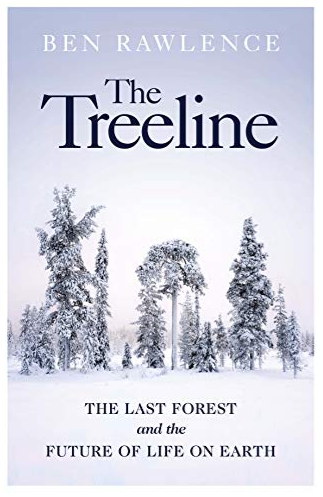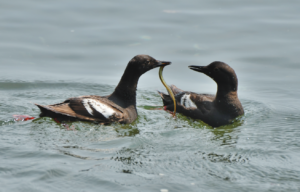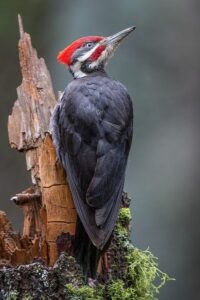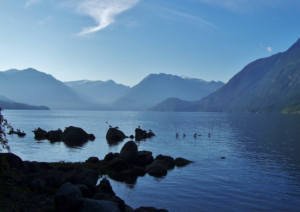The Treeline: The Last Forest and the Future of Life on Earth
by Ben Rawlence
By Anne Kilgannon
One inspirational author leads to another: I kept running across Diana Beresford-Kroeger’s work in the New York Times and in digging into her work, I discovered Ben Rawlence and his investigation of the boreal forests of the world, partly informed by Diana’s research and writing. One lit candle passing the light onto the next, illuminating a world I didn’t know! The world, it’s all connected. As birds are with trees, so we must understand the world the trees make.
If you have a globe, stand above it and look at the circle it makes at the top of the Earth; there is the geographic focus of this book. Rawlence traced a path around the globe following the line where the last forests stretch as far north as climate and geology allow before giving way to tundra and ice. “Line” is a human construct, he emphasizes, as it fluctuates wildly through the ages, especially now as trees are moving into, or out of, new territories as climate warming, drying, flooding, fires, and insect infestations impact forests. “Forest” is a construct too, I discovered: some are what we would recognize from our Northwest perspective and some are peat—forests of bygone days but still doing the job of a forest, sequestering carbon—and all kinds of formations in between. He maintains that these boreal forests may be even more important to understand and save in our efforts to survive and mitigate climate change than tropical rainforests, though our understanding of their role is not well known. His work offers us a mind-opening journey toward the knowledge we need.
In each of the six places he visits in his trips around the far northern ring of the globe, he discovers at least one keystone tree, the presence of which, however tenuous, makes, or breaks by its disappearance, the ecosystem’s ability to thrive. Each tree with its leaves or needles and reproductive parts is illustrated by exquisitely drawn images contributed by Lizzie Harper that enrich the sensory-rich portrait Rawlence creates for us. His own descriptions and stories are quietly beautiful, thoughtful, even tender, searching, and full of wonder, the best kind of science writing in the broadest sense that includes indigenous knowledge as well as the latest research. This is a book to visit and revisit, for the sheer pleasure of reading as well as the layers of discovery to be found there. It’s also a rollicking travelogue!
Rawlence begins his quest seeking an understanding of the role of boreal forests in Scotland where pioneering visionaries are working to restore—rewild—forests lost to avarice and neglect and the voracious nibbling of deer and sheep. In Scotland, the keystone species is the aptly named Scots pine. As Rawlence hikes into the backcountry, he traces the impact of the disappearing and dying forests where only a few lone ancient trees exist, unable to regenerate more of their kind unless protected by humans. Finally, almost too late, some humans are stepping up to the task and slowly turning the forces of destruction. Given a little fencing and encouragement, the “mother” pines may be able to pass on their genes to a new resurgent generation. Birds may return to do their part in seed dispersal; imported beavers can help with water management, and maybe even some restored key carnivores—wolves—can trim the abundance of deer and keep them from devouring every bud and shoot. It’s possible; success here and there may be contagious.
The next stop is Norway, in the far north in the reindeer country. There is much at stake: the survival of the birch forests, the lichen blanketing the land, the particular composition of snow found there in winter, the reindeer that depend on all three, and the deep history of the human culture fully integrated within that interdependent world. Rawlence gives us a glimpse into a vanishing way of life, of a rich trove of knowledge woven into language and folkways, skills, and generational practices that made a harsh world a home and preserved an ecosystem, now imperiled. Birch trees are at the center of the story; can they be saved? It will matter even beyond these communities of care.
Rawlence then plunges into the forests and forest keepers of Russia; truly the most harrowing journeys are recounted here. We learn about the taiga and tundra and the moving line that describes them; the keystone tree here is the larch. As cold and dark as the vast areas seem, they are not cold enough to keep the permafrost from melting and the rivers from breaking up earlier and faster, wreaking havoc. The forests play a role in the complex dance of snow and sun, leaf litter, and root networks. Some of the first research that became building blocks of knowledge about these northern forests originated in Russia, but now it’s uncertain whether the insights gleaned will be put to work on scale and in time. Rawlence traveled there before the launch of the present war; it feels even less likely that there will be an earth-saving effort supported now. It’s a hand-wringing worry.
His next stops were in Alaska and then the Hudson Bay area of northern Manitoba. In both places, Rawlence is able to draw on knowledge imbedded in native cultures developed over millennia but not often enough acknowledged by the scientific establishments. In both places, it is a story of resilience and threat, opportunity and loss. Also, sheer marvel: the lifeways and medicines derived from trees are astounding. The wonder-working of white and black spruce trees and the balsam poplar cannot be lost; it would be crushing. His writing and the work of Diana Beresford-Kroeger and others may help governments and other change agents wake up to the peril in time. The last stop of this globe-scanning is perhaps the most unique: Greenland. Despite its promising name, we rarely imagine this little-known place as a land of trees. Yet Rawlence discovers that here the mountain ash has found a foothold and as climate warming advances, so do the trees. The world has changed many times and is still evolving and morphing, for good or ill. There is so much to see and discover, to understand and integrate. Rawlence has invited us to partake in an amazing journey, to get close to six species that stand like sentinels in each of their worlds. Rawlence has given us a powerful gift of recognition, warning, and wonder. Will we heed their stories; will we return grace for grace?








